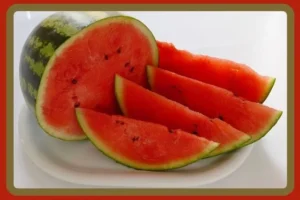Black Diamond Watermelon

The Black Diamond Watermelon is known for its dark, almost black-green rind and sweet red flesh. This heirloom variety is a summer favorite, popular for its large size and delicious flavor.
Black Diamond Watermelons stand out with their unique coloring and exceptional taste, captivating gardeners and fruit enthusiasts alike. Originating in the United States, this particular watermelon is not just a treat to the palate but a marvel to behold in any garden.
Renowned for its ability to grow up to 50 pounds, it promises an abundant harvest. Its sweet, juicy texture makes it perfect for a refreshing snack during the hot summer months. Gardeners cherish Black Diamond for its relatively high drought resistance and the generous canopy of its foliage, which protects the fruit from sunscald. Whether you’re aiming to impress at a picnic or simply looking to enjoy a natural dessert, the Black Diamond Watermelon is a delightful choice that never disappoints.
The Allure Of Black Diamond Watermelons
Black Diamond watermelons are treasures amidst garden fruits. Their deep, blue-black rinds hide the sweet, crimson flesh inside. Unlike common watermelons, these giants boast weights upwards of 50 pounds. Gardeners prize them for their exceptional taste and unusual coloration. Regularly shaped like their green cousins, these melons carry thick, tough exteriors. This protective shell ensures the flavor-packed insides remain intact until it’s time to indulge.
Cultivation Secrets
Black Diamond Watermelon thrives in warm, sunny conditions. These melons need long, hot summers to grow big and juicy. Start with well-draining soil to prevent water build-up. Soil pH should be between 6.0 and 6.8 for the best growth. Make sure to give them a lot of room; space plants about 2 to 3 feet apart. They love ample sunlight, so a spot that gets direct sun is important.
Use organic mulch to keep the soil moist. Mulch helps to control weeds too. Don’t overwater the plants; only enough should be applied. This encourages strong root growth. Fertilize before and during the growing season. Use a balanced fertilizer like 10-10-10. Protect growing melons from pests and rot. Place them on straw or use a melon cradle.

History And Origins
The Black Diamond watermelon carries a rich legacy. First documented in the early 20th century, it has been cherished for its juiciness and sweet flavor. It belongs to the family of Citrullus lanatus, cultivated widely in the United States.
Its name reflects the melon’s thick, dark green rind that looks almost black. Its origins are often linked to the southern states, where warm climates favor melons. Over time, selective breeding has enhanced its desirable traits. These include its deep red flesh and enormous size, often weighing up to 50 pounds. Gardeners and farmers continue to treasure this variety for its drought-resistant qualities.
Nutritional Profile
The Black Diamond Watermelon is not only juicy and sweet but also a nutrient powerhouse. Rich in vitamins such as Vitamin A, Vitamin C, and B vitamins, it provides essential nutrients for daily function. Minerals found in this fruit include potassium, magnesium, and iron, crucial for healthy bones, heart, and blood.
Those who eat Black Diamond Watermelon take in lycopene, an antioxidant that fights free radicals. The watermelon’s high water content keeps the body hydrated on hot days. It also has amino acids that help with blood flow and muscle health. Kids and adults alike can enjoy the health benefits of this delicious fruit.
Culinary Uses
The Black Diamond Watermelon shines in the kitchen. Its sweet, crimson flesh is perfect for summer dishes. Imagine slices of this juicy fruit adding a pop of color to your salads. Or picture it in a chilled watermelon soup that cools you on a hot day. Kids love turning it into fruity popsicles. Adults can enjoy it in a vibrant watermelon salsa. This watermelon pairs well with feta cheese, mint, and balsamic glaze. Make sure to try it in a smoothie, with some yogurt. Whatever way you slice it, the Black Diamond Watermelon is a treat. Its unique flavor brings excitement to every meal.
Harvesting Practices
Picking Black Diamond Watermelons at the right time is crucial. They are ready when the bottom turns yellow and the fruit sounds hollow when tapped. Look for the tendril to dry out near the fruit’s stem for another sign. Splitting them in half may yield an inaccurate ripeness indicator.
After harvest, cool the watermelons quickly to extend shelf life. Store them in a cool, well-ventilated place. Keep temperatures between 50-60°F (10-15°C) to maintain taste and prevent rot. Do not stack them high as their weight can cause bruising and damage. With gentle handling and proper storage, watermelons will remain delicious for weeks.
Market Trends
The Black Diamond Watermelon has seen a significant increase in popularity. It is known for its unique flavor and vibrant color. Experts note that its exotic appearance drives interest among consumers. This melon’s pricing can vary widely. Factors include seasonality and availability.
On a local scale, farmers’ markets show a steady demand. Vendors often price it as a premium product. Globally, there is a rising trend. Many countries are importing it for their luxury fruit assortments. The watermelon’s exclusivity adds to its appeal. People enjoy its sweet taste and nutritional benefits. There’s a high chance it will be a top choice for summers to come.
Growing Your Own
Growing the Black Diamond Watermelon begins with seed selection. Opt for high-quality seeds to ensure strong plants. Plant the seeds in warm, fertile soil, ensuring they are spaced properly for adequate growth. Consistent water is crucial during the early stages.
Home gardeners may face challenges such as pests and climate issues. To combat these, use natural predators like ladybugs for insect control. For climate-related concerns, employ row covers to protect plants from cold snaps. Proper care and vigilance will lead to a bountiful harvest of this unique fruit.

Conservation And Seed Sharing
Black Diamond Watermelons are unique and need protection. Their seeds are vital for future gardens. Seed sharing plays a crucial role in this effort. Gardeners and farmers across communities join hands to save and share Black Diamond Watermelon seeds.
These actions make sure we don’t lose the watermelon’s rich taste and history. Programs exist where people swap seeds. This helps in keeping the watermelon’s genetic variety strong. Everyone can help by growing the seeds and passing them on.
| Action | Benefit |
| Seed Saving | Preserves the watermelon’s traits |
| Seed Exchanging | Spreads diversity across gardens |
| Community Gardens | Teaches the value of diversity |
Beyond The Rind
The Black Diamond Watermelon sparks the minds of artists everywhere. Its deep, glossy exterior serves as a canvas for creativity. Painters often capture its stunning contrast against a bright summer backdrop.
Within folklore, the Black Diamond is a symbol of abundance and mystery. Tales tell of its magical seeds bringing fortune to those who find them. Its jet-black rind represents the unknown, while its lush red flesh suggests life and vitality.
Frequently Asked Questions Of Black Diamond Watermelon
What Is So Special About Black Diamond Watermelon?
Black Diamond watermelons boast a unique, deep dark green rind and sweet, crimson flesh. Their large size and dense texture make them a refreshing summer treat. They are heirloom melons known for their robust flavor and rarity in modern markets.
Why Are Black Diamond Watermelons So Expensive?
Black Diamond watermelons are expensive due to their rarity, labor-intensive cultivation, and limited growing regions. Their unique, sweet flavor also contributes to the higher price.
How Do You Tell When A Black Diamond Watermelon Is Ripe?
Check the watermelon’s bottom spot; a yellow color indicates ripeness. Tap the fruit; a deep, hollow sound means it’s ripe. Also, observe the tendril closest to the fruit, which should be brown and dry when it’s ready to eat.
What Is The Sweetest Watermelon?
The sweetest watermelon variety is known as the Carolina Cross, which contains high sugar levels, producing an exceptionally sweet taste.
Conclusion
Delving into the world of Black Diamond Watermelons has been intriguing. Their unique taste and intriguing appearance make them a standout treat. Whether it’s for its rich flavor or the search for a rare garden gem, this melon variety is a worthy pick.
Embrace the sweetness of summer with Black Diamond and let its charm enrich your palate and garden alike.





